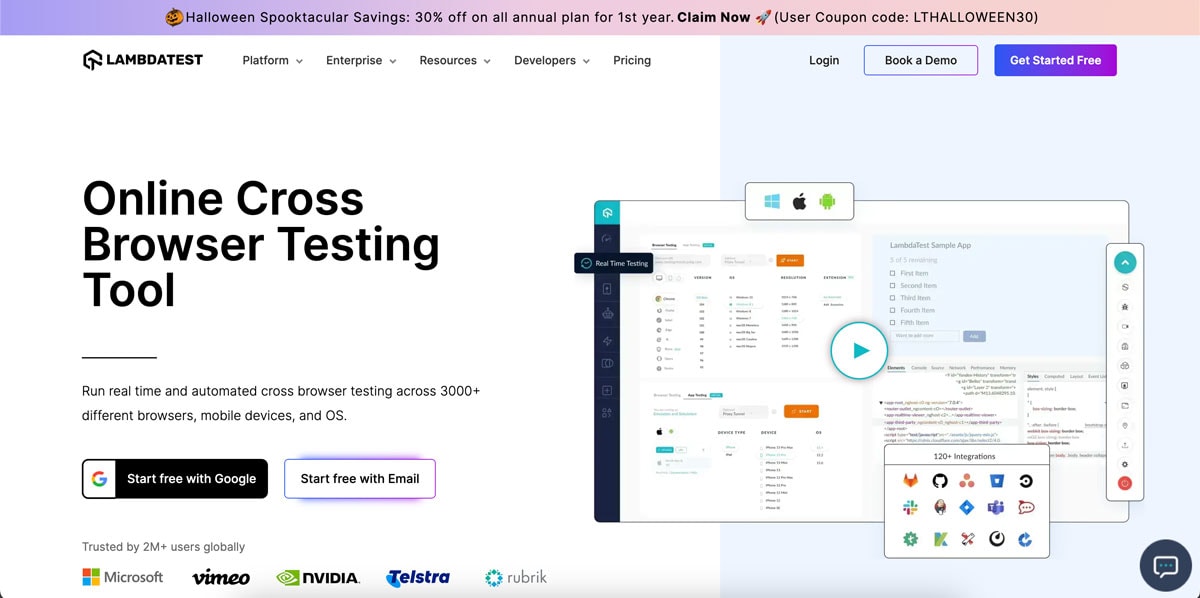In the modern era, staying ahead in web compatibility necessitates a proactive approach. As web apps become diverse and highly sophisticated, certifying their compatibility across multiple devices, browsers, and platforms is supreme. To allow flawless end-user experiences, one needs to test modern technologies differently than before, with a fresh new approach to testing and software quality authentication. World Quality Report 2023 published by Capgemini in partnership with Micro Focus and Sogeti stated that 72% of companies believe Quality Testing and Engineering can make an immense difference with the environmental facets of maintainable IT. This is why cross browser testing is crucial to your business and is considered more of a requirement than an addition to web development.
Cross Browser Testing-Overview

Credit: Pexels
READ MORE: Gen V Season 2 Release Date, Cast, Plot, Theories & Predictions
In cross-browser tests, a mobile app or website is perfectly tested to make certain it is “browser-agnostic,” i.e., functions across multiple operating systems, devices, browsers, and their amalgamations. As every single browser’s way of parsing the DOM (Document Object Model) varies significantly, the outcome is sensitive to how the software developer of the web app under testing implicitly or explicitly identifies the app’s User Interface controls.
It is critical to note that if a web app or website functions on your system, it doesn’t mean it will function on another user’s device. Hence, you need to make certain that a mobile or web app functions perfectly while accessing through:
- Multiple OS-browser combinations: Running the tests across Edge, Google Chrome, Firefox, Safari, and operating systems such as Android, macOS, Windows, Linux, and iOS.
- Varied devices: Running the cross-device testing across Smartphones, Laptops, Desktops, and Tablets.
- Assistive technologies: Your web application should be compatible with the tools used by persons with impairments.
Would you like to deepen your understanding? Browse our cross-browser testing With the cypress tutorial.
Cross-browser Testing Techniques for 2023
Now, let us explore the cross-browser testing techniques that will be crucial in the year 2023:
1. Automated Testing
Automated testing continues to be a game-changer in cross-browser tests. Test Automation frameworks such as Playwright, Selenium, Appium, and enable you to write scripts that can implement tests at once across multiple platforms and browsers. This not just reduces testing time but also enhances test consistency and coverage.
2. Headless Browsers
Headless browsers operate without a GUI (graphical user interface), making them resource-efficient and faster than traditional browsers. They are perfect for test automation, particularly in CI/CD (Continuous Integration/Continuous Deployment) pipelines, where efficiency and speed are supreme.
3. RUM (Real User Monitoring)
Real User Monitoring tools gather data on how real users interact with your site in distinct browsers and environs. This data is important for finding browser-centric issues and prioritizing test efforts accordingly. Real-User Monitoring also gives insights into real-world consumer behavior.
4. Cloud-Based Testing
Leveraging cloud-centric testing platforms like LambdaTest enables QA professionals to access an extensive suite of device and browser combinations without the necessity for extensive local infrastructure. This flexibility is mainly beneficial when dealing with a varied user base.
5. Visual Regression Testing
Visual regression test tools, such as Applitools, can easily compare screenshots of web pages across varied browsers to discover visual discrepancies. This method is vital for confirming consistent layout and design, particularly as web apps become more intricate.
6. Mobile Testing
While mobile usage on the rise, mobile cross-browser tests is necessary. Tools such as XCUITest and Appium are used for testing mobile apps across multiple devices and OS versions.
7. PWAs (Progressive Web Application) Tests
Progressive Web Apps (PWAs) are becoming gradually more popular, and testing methods for Progressive Web Apps need to encompass several browsers and their support for PWA traits. PWAs blur the lines between native and web apps, making compatibility tests crucial.
8. ML and AI-Powered Tests
Machine learning (ML) and Artificial intelligence (AI) are being used to forecast potential problems in diverse browsers and suggest solutions. Such technologies can considerably reduce testing effort & time by automatically detecting and addressing compatibility problems.
9. DevOps Incorporation
Incorporating cross-browser tests into the DevOps pipeline confirms that testing is smooth and continuous. Automated regression testing can automatically run whenever there are code modifications, promoting early problem detection and speedy feedback loops.
10. User-Agent Switching
Switching user-agent strings in web browsers can aid in emulating distinct devices and browsers. But, it’s significant to note that this technique isn’t a substitute for actual tests, as it might not capture all compatibility glitches.
11. Browser Emulation
Simulating traditional browser versions or rare browser configurations helps guarantee backward compatibility and a reliable user experience. Simulators and Emulators offer a controlled environment for testing.
Why Lambdatest for performing Cross-Browser testing?

Credit: LambdaTest
READ MORE: Elite Season 8 Release Date, Cast, Plot, Theories & Predictions
Cross-browser testing on the cloud is a convenient and easy web and mobile app testing technique without worrying about the local infrastructure. Cloud testing assists you in using varied machines and several resources online without exhausting your resources on removing constraints like devices, browsers, and Operating System coverage.
However, while running cross-browser testing, covering all the cutting-edge and legacy operating systems browsers, browser versions, and devices, can be cumbersome. Besides, setting up an in-house test infrastructure can put a dent in the company’s budget, and management of the browser and OS updates can take substantial bandwidth from your DevOps or IT team.
This is where AI-powered test orchestration and test execution platforms like LambdaTest assist you and mitigate the issue of guaranteeing that a site and web app function faultlessly across multiple devices, browsers, and platform combinations. Cross-browser test tools are hosted on the cloud instead of the developer’s local machine. This results in very effective testing without installing various testing environments on their workstations.
LambdaTest a test execution and test orchestration (cloud-centric) platform offers testing on real-time devices and virtual surroundings. It allows you to run both automated and manual cross-browser testing for mobile and web across on-demand real devices, browsers, and OSs on its scalable cloud grid. LambdaTest is considered one of the best cross-browser testing tools, with support for automated test scripts with diverse testing frameworks such as Playwright, Cypress, Appium, Selenium, XCUITest, Espresso, etc.
Crucial Traits of LambdaTest
You can even run live interactive testing in real-time browser environments. Hence, it assists you in testing your mobile app or website on an extensive series of iOS, Android, Windows, and macOS platforms, including legacy and modern mobile and desktop browsers.
- Run test automation with diverse frameworks and programming languages on an online browser farm of 3000 plus actual mobile and desktop environments.
- Real-time cross-browser tests on Real Cloud (Device).
- Accelerate your automated testing with HyperExecute – an intense fast next-gen E2E test orchestration cloud.
- Test At Scale – an open-source test management and flaky test selection platform proffers you to accelerate tests, cut job times, and get speedy feedback on code commits.
- Smart Visual Regression Tests on the cloud to detect visual deviations.
- 120+ 3rd-party incorporations with tools for Codeless Automation, Project Management, CI/CD, and more.
- Run Localhost tests of mobile and web apps.
- Geolocation tests of mobile and web applications across 53+ geographies.
- Chromium-centric LT Browser 2.0 – for speedy responsive testing across 50+ pre-installed device viewports.
Pros:
- Automation competencies help fasten testing processes
- Wide device and browser coverage, including desktop and mobile browsers.
- Real-time device test aids ensure maximum browser compatibility coverage.
- Live interactive tests enable software developers to test their web apps in real time.
- Incorporates multiple testing tools and frameworks.
Cons:
- Restricted customization options
- Pricing plans can be costly for small teams
- Some users might encounter occasional problems with the platform’s performance.
You can also subscribe to the LambdaTest YouTube Channel and acquire tutorials around Cypress testing, Playwright, Selenium testing, and more.
What are the advantages of Cross Browser Testing Tools?

Credit: Pexels
READ MORE: Goosebumps Season 2 Release Date, Cast, Plot, Theories & Predictions
Cross-browser testing provides various benefits that contribute to the overall reliability and quality of web apps. Let’s take a glance at some of the crucial benefits:
- Bug Identification: Helps detect and mitigate browser-centric bugs and issues, confirming that your web app behaves properly and displays content perfectly in all scenarios.
- Consistent User Experience: Make certain that your web app looks and functions constantly across distinct devices, browsers, and platforms, giving a smooth experience for all users.
- Broader Audience Reach: Reaches a wide audience by accommodating consumers who prefer distinct devices or browsers. Ignoring definite browsers could mean excluding an important portion of potential consumers.
- Enhanced SEO: A well-optimized site that functions perfectly across browsers is likely to rank high in search engine outcomes, enhancing its visibility and attracting higher organic traffic.
- Improved Performance: Makes certain that your web app performs perfectly and loads rapidly in several browsers, optimizing user experience and dropping bounce rates.
- Accessibility and Compliance: Guarantees compliance with web standards and accessibility guidelines, making your web app accessible to customers with disabilities and avoiding possible legal issues.
- User Satisfaction: Delivers a reliable and consistent user experience, resulting in higher user retention, higher user satisfaction, and positive word-of-mouth recommendations.
- Cost Savings: Reduces the expense of fixing browser-centric problems post-launch, as detecting and mitigating these issues during development is highly lucrative.
- Cross-Platform Compatibility: Certifies that your web app functions appropriately on varied operating systems (Linux, macOS, Windows) and across several browser versions.
- Rapid Bug Resolution: Detects issues in real-time, letting software development teams resolve them efficiently and rapidly, averting the accumulation of unresolved bugs.
- Quality Assurance: Improves the overall QA process by detecting and addressing compatibility issues early in the software development cycle, minimizing the threat of late-stage defects.
- Improved User Retention: Consistency in user performance and experience enhances user retention and loyalty, reducing the existence of users switching to competitors.
- Cross-Browser Analytics: Collect information on how users communicate with your web app on distinct web browsers, assisting you in making data-driven decisions for optimization, enhancement, and feature development.
- Competitive Advantage: Validates a commitment to delivering a superior-quality product, which can give your app an edge in the digital landscape.
If you are seeking a cross-browser testing cloud with scalable and affordable pricing, try LambdaTest. You can kickstart your testing journey with this pristine platform and get your first 100 automation minutes FREE.
Frequently Asked Questions (FAQs)
What is cross-browser testing, and why is it significant in 2023?
Cross-browser testing is the approach to ensure that a web app functions constantly and appropriately across distinct web devices, browsers, and platforms. In 2023, it is essential because of the diverse browser landscape and the requirement to provide a flawless user experience to an extensive audience.
How can automation benefit cross-browser tests in 2023?
Automation tools such as Playwright and Selenium enable QA testers to execute tests concurrently across multiple browsers, improving coverage, reducing testing time, and confirming constancy in test execution.
What role does ML and AI play in cross-browser testing in 2023?
ML and AI are used to predict possible compatibility problems, suggest solutions, and automate the test procedure. They can considerably reduce testing effort and time.
How can cross-browser testing be incorporated into the DevOps pipeline?
Cross-browser tests can be flawlessly incorporated into the DevOps pipeline, letting automated tests execute with each code change, encouraging early bug detection and speedy feedback.
Why is RUM (real user monitoring) valuable in cross-browser testing?
RUM (real user monitoring) tools gather data on how real-time consumers interact with a web app, giving insights into browser-centric issues and assisting in prioritizing testing efforts.
















